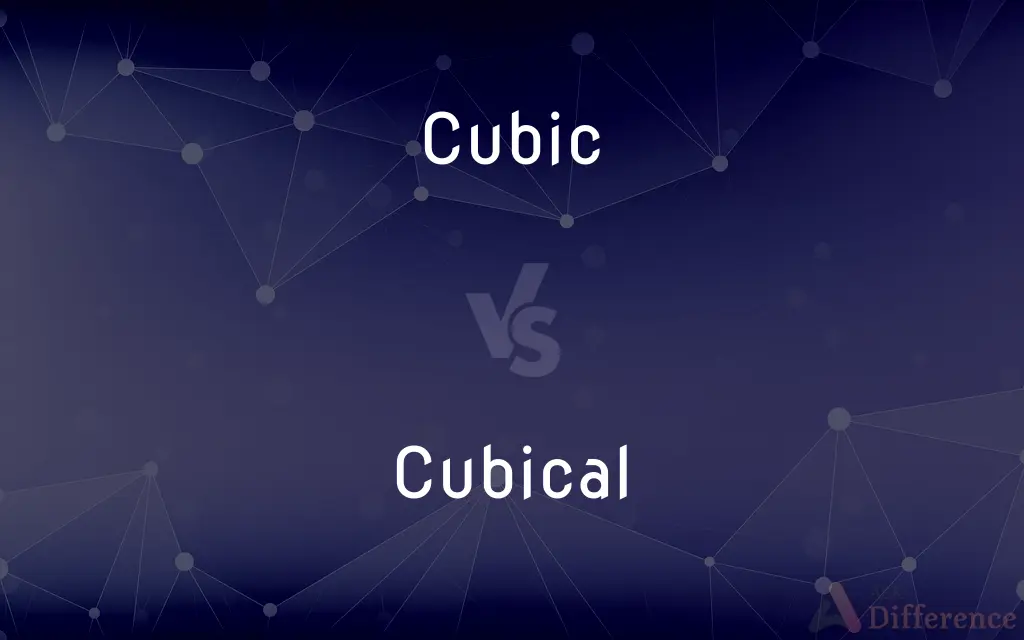Cubic vs. Cubical — What's the Difference?
Edited by Tayyaba Rehman — By Maham Liaqat — Updated on May 9, 2024
Cubic refers to something shaped like a cube or involving the third power, while cubical means resembling a cube or having a cube-like shape.

Difference Between Cubic and Cubical
Table of Contents
ADVERTISEMENT
Key Differences
Cubic is a term often used in mathematics and geometry, where it relates to the third power of a number or volume measurement. It also describes objects precisely in the shape of a cube. Cubical, on the other hand, pertains to objects that resemble a cube in shape but might not have precise measurements, like cubical structures or rooms.
Cubic applies to exact cubic measurements, like "cubic meters," whereas cubical is more about shape, such as cubical storage units. Cubic may also relate to polynomial equations of the third degree, while cubical lacks this mathematical association.
When considering units of measurement, cubic is specific, like cubic feet or cubic inches, while cubical might describe a similar space that is cube-like but not measured strictly.
Cubic appears more frequently in scientific, engineering, and mathematical contexts due to its precision. Cubical finds more common usage in everyday language and architecture, describing rooms or containers resembling a cube.
Comparison Chart
Geometry
Precisely shaped like a cube
Resembles a cube in general shape
ADVERTISEMENT
Mathematical Use
Relating to the third power
No direct mathematical association
Measurement
Used with specific measurements
Describes cube-like spaces or structures
Engineering
Used for volumetric calculations
Less frequent usage
Common Usage
Scientific, technical contexts
Architectural, everyday language
Compare with Definitions
Cubic
Refers to the shape of a cube.
The object had a cubic shape, perfect for the art installation.
Cubical
Refers to a general cube-like shape.
The building has a cubical design.
Cubic
Describes measurements in three dimensions.
The volume of the box is 3 cubic feet.
Cubical
Indicates a shape or object approximating a cube.
The storage boxes were cubical.
Cubic
In chemistry, refers to cubic crystal systems.
Sodium chloride forms a cubic lattice structure.
Cubical
Suggests a three-dimensional, somewhat square-like structure.
The cubical bookshelf was perfect for small apartments.
Cubic
Relates to a polynomial equation of degree three.
A cubic equation can have up to three roots.
Cubical
Pertains to cubicles, which are modular office spaces.
The employees sat in their cubical spaces.
Cubic
Denotes a unit of measure, like cubic meters or cubic centimeters.
The tank can hold 50 cubic meters of water.
Cubical
Describes rooms or spaces resembling a cube.
The office features cubical workspaces.
Cubic
Having the shape of a cube.
Cubical
Cubic.
Cubic
Shaped similar to a cube.
Cubical
Of or relating to volume.
Cubic
Having three dimensions.
Cubical
Of or pertaining to a cube; cubic.
Cubic
Abbr. c or cu. Having a volume equal to a cube whose edge is of a stated length
A cubic foot.
Cubical
Shaped like a cube
Cubic
(Mathematics) Of the third power, order, or degree.
Cubic
Of or relating to a crystalline form that has three equal axes at right angles to each other; isometric.
Cubic
A cubic expression, curve, or equation.
Cubic
(geometry) Used in the names of units of volume formed by multiplying a unit of length by itself twice.
Cubic foot
Cubic
(algebraic geometry) Of a class of polynomial of the form Category:en:Polynomials
Cubic
(crystallography) Having three equal axes and all angles 90°.
Cubic cleavage
Cubic
(algebraic geometry) A cubic curve. Category:en:Curves
Cubic
Having the form or properties of a cube; contained, or capable of being contained, in a cube.
Cubic
Isometric or monometric; as, cubic cleavage. See Crystallization.
Cubic
A curve of the third degree.
Cubic
Involving two dimensions
Common Curiosities
Is cubical a commonly used term?
Cubical is often used in architecture and everyday language to describe cube-like shapes or structures.
What does cubic mean?
Cubic refers to anything shaped like a cube or related to the third power in math.
What does cubical mean?
Cubical describes anything generally resembling a cube in shape.
Can cubic and cubical be used interchangeably?
No, cubic is specific to precise shapes and measurements, while cubical is broader and relates to resemblance.
Does cubical always refer to cubicle workspaces?
No, cubical can describe any object that resembles a cube, not just office cubicles.
Are cubical objects perfectly cube-shaped?
Not necessarily; cubical objects generally resemble a cube but might not have perfectly equal dimensions.
Is cubic always related to math?
No, cubic can also describe objects that are precisely cube-shaped or related to three-dimensional volume.
Are cubical shapes common in everyday life?
Yes, cubical shapes like boxes, storage units, and rooms are commonly encountered.
Is cubic used for measuring volume?
Yes, "cubic" is used to measure volume, such as cubic meters or cubic feet.
What is a cubic equation?
A cubic equation is a polynomial equation where the highest exponent of the variable is three.
Is "cubic" an adjective or noun?
Cubic is an adjective when describing shapes or measurements, but it can be a noun when referring to cubic equations.
Does cubical have specific dimensions?
Cubical doesn't refer to specific dimensions but rather suggests a cube-like shape.
Is cubic used in geometry?
Yes, cubic is used to describe objects precisely in the shape of a cube and for measurements involving three dimensions.
Is cubic limited to a specific scientific field?
No, it's used in mathematics, chemistry, engineering, and other fields involving measurements or geometric shapes.
Can cubical objects have rounded edges?
Yes, cubical objects may not be perfectly cubic and can have rounded edges while still resembling a cube in shape.
Share Your Discovery

Previous Comparison
Toluene vs. Turpentine
Next Comparison
Resin vs. RaisinAuthor Spotlight
Written by
Maham LiaqatEdited by
Tayyaba RehmanTayyaba Rehman is a distinguished writer, currently serving as a primary contributor to askdifference.com. As a researcher in semantics and etymology, Tayyaba's passion for the complexity of languages and their distinctions has found a perfect home on the platform. Tayyaba delves into the intricacies of language, distinguishing between commonly confused words and phrases, thereby providing clarity for readers worldwide.













































